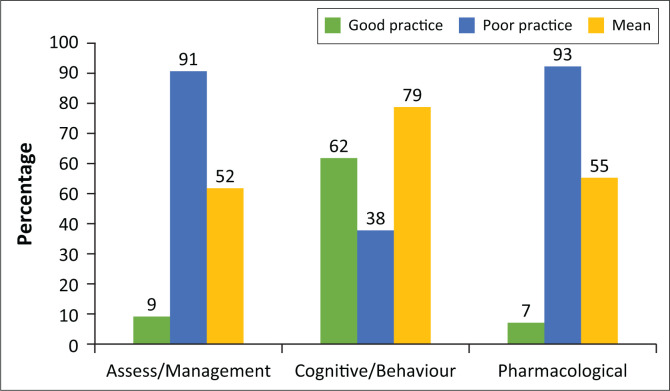Knowledge, attitudes and practice of clinicians managing chronic pain in a tertiary care facility.
IF 1
Q4 REHABILITATION
South African Journal of Physiotherapy
Pub Date : 2022-01-31
eCollection Date: 2022-01-01
DOI:10.4102/sajp.v78i1.1597
引用次数: 0
Abstract
Background Chronic pain is a common clinical symptom and has a high socio-economic and health burden on patients, clinicians and the healthcare sector. Globally, clinicians continue to exhibit limited knowledge, negative attitudes and misconceptions about chronic pain, raising public health concerns. Objective Our study aimed to determine the level of knowledge, attitudes and practices of clinicians towards assessment and management of patients with chronic pain in a tertiary hospital. Methods This cross-sectional study at a tertiary care hospital in Kenya adopted a census method to recruit participants (n = 240). A questionnaire containing 77 items derived from the Revised Pain Knowledge and Attitudes Questionnaire (RPKAQ) and the Knowledge and Attitudes Survey regarding Pain (KASRP) was used to collect data. The questionnaire had three parts. Part A had six items to determine information on demographic characteristics. Part B and C had 54 and 23 items, respectively, that determined information on knowledge, attitudes and practice of clinicians managing chronic pain. Data were analysed using SPSS Version 24. Results Response rate was 83.3% (n = 153). Only 9% (n = 14) of the respondents were believed to have adequate knowledge and positive attitudes; 62% (n = 95) used best practice for cognitive/behavioural management of chronic pain. Few (9% n = 14) used best practice in the assessment and measurement of chronic pain. Conclusion There is inadequate knowledge, attitudes and practices amongst clinicians regarding assessment and management of chronic pain. Future research is needed in a wider population to compare these results. Clinical implication It may motivate clinicians to improve their level of knowledge, attitudes and practices for pain management, hence improving poor chronic pain outcome.

三级医疗机构中临床医生管理慢性疼痛的知识、态度和实践。
背景:慢性疼痛是一种常见的临床症状,对患者、临床医生和医疗保健部门具有很高的社会经济和健康负担。在全球范围内,临床医生继续对慢性疼痛表现出有限的知识、消极的态度和误解,引起了公众健康关注。目的:本研究旨在了解三级医院临床医生对慢性疼痛患者评估和管理的知识水平、态度和做法。方法:本横断面研究在肯尼亚的一家三级保健医院采用人口普查方法招募参与者(n = 240)。采用《疼痛知识与态度调查》(RPKAQ)和《疼痛知识与态度调查》(KASRP)中的77项问卷进行数据收集。问卷分为三部分。A部分有六个项目确定关于人口特征的资料。B部分和C部分分别有54和23个项目,确定了临床医生管理慢性疼痛的知识、态度和实践信息。数据分析使用SPSS Version 24。结果:有效率为83.3% (n = 153)。只有9% (n = 14)的受访者被认为有足够的知识和积极的态度;62% (n = 95)采用慢性疼痛认知/行为管理最佳实践。很少(9% n = 14)在评估和测量慢性疼痛时采用最佳做法。结论:临床医生对慢性疼痛的评估和管理存在知识、态度和实践上的不足。未来的研究需要在更广泛的人群中比较这些结果。临床意义:它可以激励临床医生提高他们的知识水平,态度和实践疼痛管理,从而改善慢性疼痛预后不良。
本文章由计算机程序翻译,如有差异,请以英文原文为准。
求助全文
约1分钟内获得全文
求助全文
来源期刊

South African Journal of Physiotherapy
REHABILITATION-
CiteScore
1.70
自引率
9.10%
发文量
35
审稿时长
30 weeks
 求助内容:
求助内容: 应助结果提醒方式:
应助结果提醒方式:


